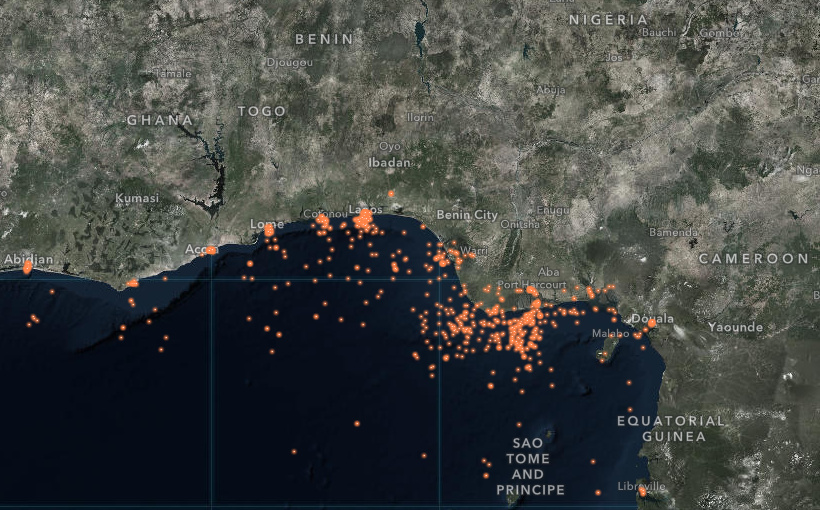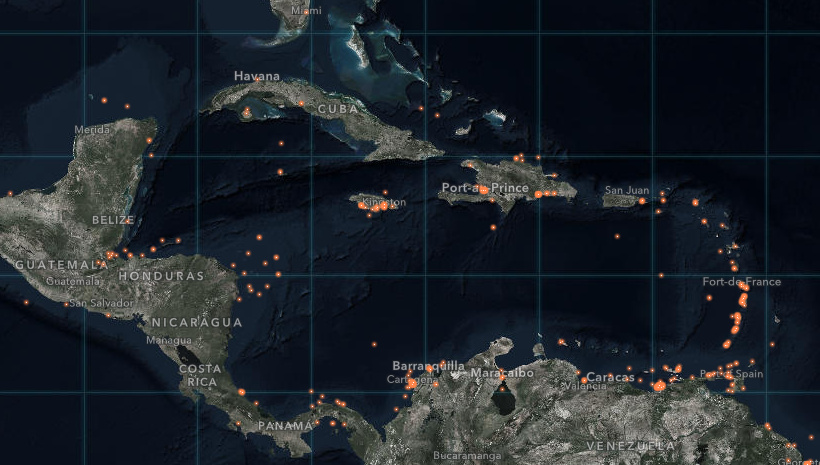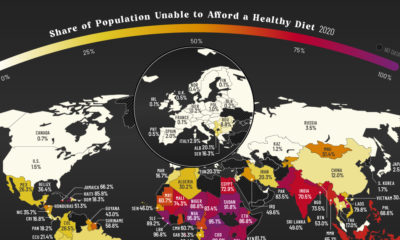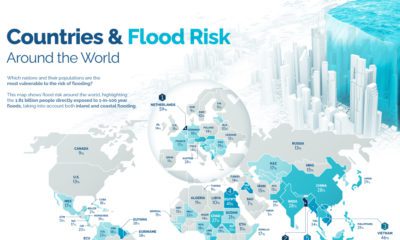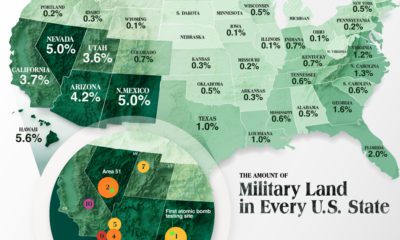For millennia, voyaging on the open seas has been a dangerous and risky endeavor. Between the powerful forces of Mother Nature and self-made obstacles stemming from human error, there is no shortage of possible calamities for even the bravest of sailors. But for most of human history, perhaps the biggest fear that sailors grappled with was that of piracy. A run in with such marauders could lead to the theft of valuable cargo or even possible death, and it’s a threat that carries on even through modern times.
Hotbeds of Modern Piracy
Today’s map comes from Adventures in Mapping and it aggregates instances of piracy over the last 40 years based on the database from the National Geospatial-Intelligence Agency. It should be noted that all individual events can be seen on this interactive map, which is what we will use to look at current hotbeds of piracy in more depth below.
1. The Strait of Malacca
The Strait of Malacca is one of the world’s most important shipping lanes, and also one of the most notorious. A key chokepoint that sits between Malaysia and Indonesia, the Strait of Malacca is as narrow as 25 miles wide while also seeing a quarter of the world’s traded goods shipped through it every year. As a result, the strait and surrounding area are a frequent target for modern piracy. Example account: (September 2002) “The 1,699-ton Malaysian-flag tanker (NAUTICA KLUANG) was hijacked 28 Sep at 0300 local time while underway off Indonesia in the vicinity of Pulau Iyu Kecil at the southern tip of the Strait of Malacca. The pirates, armed with guns and machetes, tied up the crew and locked them in cabins. When the crew freed themselves at 0900, 29 Sep, the thieves had transferred the ship’s cargo of 3,000 tons of diesel oil, damaged communications equipment, and renamed it (CAKLU). ”
2. The Horn of Africa
When many people think of modern piracy, they think of the coast of Somalia. While those waters are often avoided, the nearby areas can be just as problematic. In particular, the Bab el Mandeb strait, which connects the Red Sea to the Indian Ocean, is a target for modern piracy. Similarly, the waters just off of Yemen are quite treacherous as well. Example account: (January 1991) “Somali pirates attached MV Naviluck off Somalia, killing three Filipino crewmen and setting fire to the vessel. Three boatloads of armed Somali pirates boarded the vessel on 12 Jan 91 took the crew ashore and killed three of them. The captain said the vessel was attacked off Xaafuun while on her way from Mombasa to Jeddah. He declined to specify the cargo. The surviving crew were made to jump overboard, and were later rescued by M Stern TRLR Dubai Dolphin.”
3. The Gulf of Guinea
While we hear the most about Somalian pirates, the Gulf of Guinea that sits south of Nigeria, Benin, Togo, and Ghana in West Africa is also a well-known hotbed. Tanker theft of petroleum products being shipped to and from Nigerian refineries is rampant, creating an ongoing concern for companies operating in the region. Example account: (June 2013) “On 13 June, the Singapore-flagged underway offshore supply vessel MDPL CONTINENTAL ONE was boarded and personnel kidnapped at 04-02N 008-02E, approximately 7 nm southwest of the OFON Oil Field. Two fiberglass speedboats, each with 2 outboards engines, each carrying 14 gunmen in wearing casual t-shirts and no masks, launched an attack. The pirates were armed with AK47’s. After stealing personal items and belongings, four expat crew were kidnapped (Polish Chief Engineer) and three Indians (Captain, Chief Officer, and Bosun).”
4. The Caribbean
The Caribbean has a longstanding history with piracy – and while things have died down considerably since the peak, there are still isolated incidents that occur, especially with yachts. Most incidents happen off the coast of Venezuela, or in and around the islands on the eastern side of the sea, such as Trinidad & Tobago, Barbados, and Grenada. Example account: (March 2016) “On 4 March, near position 13-16N 061-16W, several gunmen boarded a yacht anchored at Wallilabou in southwestern St. Vincent. During the course of the boarding, a German citizen aboard the yacht was killed and another person was injured. Authorities are investigating the incident.” on Even while political regimes across these countries have changed over time, they’ve largely followed a few different types of governance. Today, every country can ultimately be classified into just nine broad forms of government systems. This map by Truman Du uses information from Wikipedia to map the government systems that rule the world today.
Countries By Type of Government
It’s important to note that this map charts government systems according to each country’s legal framework. Many countries have constitutions stating their de jure or legally recognized system of government, but their de facto or realized form of governance may be quite different. Here is a list of the stated government system of UN member states and observers as of January 2023: Let’s take a closer look at some of these systems.
Monarchies
Brought back into the spotlight after the death of Queen Elizabeth II of England in September 2022, this form of government has a single ruler. They carry titles from king and queen to sultan or emperor, and their government systems can be further divided into three modern types: constitutional, semi-constitutional, and absolute. A constitutional monarchy sees the monarch act as head of state within the parameters of a constitution, giving them little to no real power. For example, King Charles III is the head of 15 Commonwealth nations including Canada and Australia. However, each has their own head of government. On the other hand, a semi-constitutional monarchy lets the monarch or ruling royal family retain substantial political powers, as is the case in Jordan and Morocco. However, their monarchs still rule the country according to a democratic constitution and in concert with other institutions. Finally, an absolute monarchy is most like the monarchies of old, where the ruler has full power over governance, with modern examples including Saudi Arabia and Vatican City.
Republics
Unlike monarchies, the people hold the power in a republic government system, directly electing representatives to form government. Again, there are multiple types of modern republic governments: presidential, semi-presidential, and parliamentary. The presidential republic could be considered a direct progression from monarchies. This system has a strong and independent chief executive with extensive powers when it comes to domestic affairs and foreign policy. An example of this is the United States, where the President is both the head of state and the head of government. In a semi-presidential republic, the president is the head of state and has some executive powers that are independent of the legislature. However, the prime minister (or chancellor or equivalent title) is the head of government, responsible to the legislature along with the cabinet. Russia is a classic example of this type of government. The last type of republic system is parliamentary. In this system, the president is a figurehead, while the head of government holds real power and is validated by and accountable to the parliament. This type of system can be seen in Germany, Italy, and India and is akin to constitutional monarchies. It’s also important to point out that some parliamentary republic systems operate slightly differently. For example in South Africa, the president is both the head of state and government, but is elected directly by the legislature. This leaves them (and their ministries) potentially subject to parliamentary confidence.
One-Party State
Many of the systems above involve multiple political parties vying to rule and govern their respective countries. In a one-party state, also called a single-party state or single-party system, only one political party has the right to form government. All other political parties are either outlawed or only allowed limited participation in elections. In this system, a country’s head of state and head of government can be executive or ceremonial but political power is constitutionally linked to a single political movement. China is the most well-known example of this government system, with the General Secretary of the Communist Party of China ruling as the de facto leader since 1989.
Provisional
The final form of government is a provisional government formed as an interim or transitional government. In this system, an emergency governmental body is created to manage political transitions after the collapse of a government, or when a new state is formed. Often these evolve into fully constitutionalized systems, but sometimes they hold power for longer than expected. Some examples of countries that are considered provisional include Libya, Burkina Faso, and Chad.


